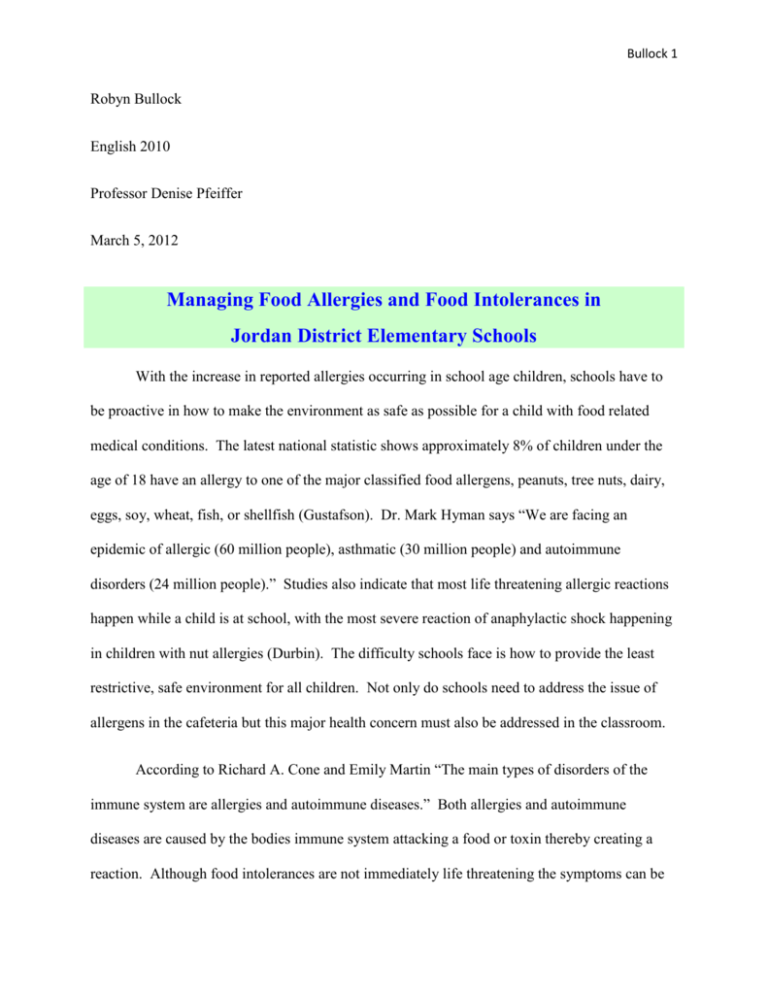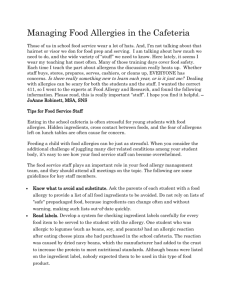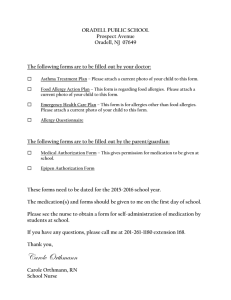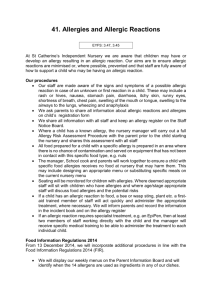Managing Food Allergies and Food Intolerance in
advertisement

Bullock 1 Robyn Bullock English 2010 Professor Denise Pfeiffer March 5, 2012 Managing Food Allergies and Food Intolerances in Jordan District Elementary Schools With the increase in reported allergies occurring in school age children, schools have to be proactive in how to make the environment as safe as possible for a child with food related medical conditions. The latest national statistic shows approximately 8% of children under the age of 18 have an allergy to one of the major classified food allergens, peanuts, tree nuts, dairy, eggs, soy, wheat, fish, or shellfish (Gustafson). Dr. Mark Hyman says “We are facing an epidemic of allergic (60 million people), asthmatic (30 million people) and autoimmune disorders (24 million people).” Studies also indicate that most life threatening allergic reactions happen while a child is at school, with the most severe reaction of anaphylactic shock happening in children with nut allergies (Durbin). The difficulty schools face is how to provide the least restrictive, safe environment for all children. Not only do schools need to address the issue of allergens in the cafeteria but this major health concern must also be addressed in the classroom. According to Richard A. Cone and Emily Martin “The main types of disorders of the immune system are allergies and autoimmune diseases.” Both allergies and autoimmune diseases are caused by the bodies immune system attacking a food or toxin thereby creating a reaction. Although food intolerances are not immediately life threatening the symptoms can be Bullock 2 similar and usually involve the digestive system. Timi Gustafson states, “There can be conditions, where food tolerance and allergies overlap. Celiac disease, for example.” She goes on to explain that some food intolerances such as celiac trigger an autoimmune response as does an allergic reaction. Therefore parents and schools must be as diligent in keeping a safe environment for those children diagnosed with autoimmune food intolerance as well as those diagnosed with food allergies (Dana Korn). Children in school constantly come in contact with possible allergens on a regular basis. Teachers have arts and craft projects, counting assignments that use food as manipulatives, and science project using food to teach a concept. Parents enjoy bring treats to celebrate a child’s birthday. Class parties are held in which food is served. A person with a food allergy does not have to eat a food to have a reaction; touching that food item can also cause a severe reaction. Hand washing at school is another concern. Children do not always wash their hands after eating or touching a food another student might be allergic too. Then if that child who ate the food touches the child with an allergy it can create an allergic reaction. It is imperative that parents teach a child with allergies safety practices and to say no to non-approved treats. Depending on a child’s age that child should be taught to recognize the symptoms of an anaphylactic reaction and to tell a trusted adult. Even with that training and information from the parents of a child with an allergy, classroom teachers should be proactive in trying to provide a safe environment. Teachers should know the warning signs of an allergic reaction and anaphylactic shock. Virginia and six other states have legislation underway “which would allow school officials to administer epinephrine to students believed to be in anaphylactic shock.” according to Bullock 3 the report Food Allergy: A National and Deadly Problem. This proposed legislation is in response to deaths or near deaths that have occurred in that state. A student would not have to have a known diagnosis with a prescribed EpiPen available for school personnel to administer the epinephrine in cases of emergency. The state of Utah does not currently have any proposed legislation regarding allergies in schools. Schools should not mandate a school wide ban on certain foods. Doing so could create an environment in which students with allergies feel a false sense of security (Jeanette Bradley). No place outside of the home should be considered allergy free. Placing a ban could also create a situation in which other children will feel deprived and could lead to bullying. Schools should make decisions on a case-by-case basis since every child with an allergy can react differently. There are also too many types of allergens to make such a ban practical. Warning Signs of Allergic Reactions or Anaphylactic Shock The warning signs are different with each person. The most common symptoms are “tingling of the mouth, skin rash, nasal congestion, vomiting, abdominal cramps, diarrhea, dizziness, swelling of the tongue and throat,” according to Dr. Gerard Lalande. When those symptoms turn to anaphylaxis it becomes life-threatening, since most often there will be swelling of the throat making it difficult to breathe. It can also cause possible loss of consciousness or the heart to stop. This condition can rapidly result in death if untreated. Treatment for mild allergic reactions can be over-the-counter or prescription antihistamines, but as Dr. Gerard Lelande states a “severe allergic reaction is a medical emergency, requiring an immediate injection of adrenaline.” Symptoms can occur anywhere from a few seconds up to two hours after contact with the allergen (Jordan School District). Bullock 4 Current Jordan School District Allergy Policy All allergies are considered a critical medical issue (Jordan School District). Parents are asked to request a health care plan. This request provides district nurses with the authorization to contact a child’s doctor and with the physician’s recommendation draft a plan for prevention and treatment of allergic reactions. Along with the health care plan a physician will need to sign the district approved form for medication to be administered at school. Parents need to bring the signed prescription form and non-expired prescribed medication to the school. All medication must have a pharmacy label with the child’s name, instructions and expiration date. At the elementary school level children are able to carry Epi-Pens and inhalers. Other medications must be kept secured in the office. This is due to the urgent nature of an allergic incident where a child must receive the prescribed medication immediately. When the school has students that will possibly need an EpiPen injection nursing services will provide training as to proper administration to school staff. An EpiPen is injectable epinephrine that will prevent a child from going into immediate anaphylactic shock from ingesting an allergen. The current district guideline is that three employees must be trained at each school (Jordan School District). Each individual trained in EpiPen use must be retrained each year. Once an EpiPen has been administered that employee stays with the student while other school personnel calls 911 and contacts the parents. The employee will give the used EpiPen to the paramedics or EMTs upon arrival at the school. Even though two doses are usually required at 15 minute intervals, Jordan District employees are authorized only to administer the first dose. Bullock 5 Elementary School Cafeteria’s in Jordan School District With the increase of life threatening occurrences of anaphylactic shock due to peanuts and tree nuts all Jordan School District cafeterias do not serve nuts in any form in school lunches. Nutrition serves also makes a concerted effort to purchase foods from manufacturers that do not process nuts in their facilities. However Nutrition Services has no control over what other children bring from home for their lunches. To provide a safe alternative so students do not have a reaction to cross contamination many schools provide a nut-free table. Unfortunately children sometimes feel isolated when they cannot sit with classmates (Jeanette Bradley). This policy addresses two of the major allergies, peanuts and tree nuts but does not address the children with allergies in the other major groups which are milk, eggs, wheat, soy, and fish/shellfish (Jeanette Bradley). This is because most deaths from anaphylactic shock in school age children are caused by a reaction to peanuts. It is not practical to have a separate table for each type of allergy. Jordan District Nutrition Services has a Diet Prescription for Meals at School form that can be filled out by a student’s physician that can provide the cafeteria with information regarding a child’s need for a special school meal (Jordan School District). When school cafeteria personnel receive the request for special meals the information is forwarded to the dietitian at Jordan District Nutrition Services. In conjunction with the parents, cafeteria manager, and Jordan District dietitian a food plan is provided. Since there is only one dietitian for the entire district this can sometimes take weeks before it is in place. The ingredient Bullock 6 information on foods prepared or purchased by the district is often very difficult to receive by the parents. Many times parents are frustrated and due to that frustration choose to send a sack lunch from home rather than have their children eat a school prepared lunch. Parents Responsibility in the School Setting It is critical that a parent is a child’s advocate in regards to a food allergy. If a child is diagnosed before starting kindergarten a parent should be proactive and notify the school of the child’s allergy; by doing so a health care plan can be in place prior to a child even attending school. If a child develops an allergy while attending school a parent should provide information prior to the child returning to the classroom. The parent needs to fill out the appropriate paperwork and be in communication with the teacher, cafeteria manager and office staff so key personnel are aware of the specific allergy and the child’s reaction to the food. Not all patients have the same reaction to foods so it is important that staff knows the specific reaction. Parents should provide a box of approved treats to be kept in the classroom. These approved treats would be available for those times when another parent or child brings food to celebrate a birthday or some other event. The child would then receive a treat, even though it is not the same as everyone else. This helps the child feel included while providing a safe food alternative. Parents should be invited to accompany their child on field trips. This would provide supervision if their student should have an allergic reaction. If a parent is not available to attend the teacher should make sure to have the student with them at all times. That teacher should be trained in the use of the EpiPen in case of an allergic emergency. Parents should be notified when there will be a special event that will involve food, such as a holiday celebration or reward party. A proactive parent will participate in the planning of Bullock 7 such events therefore creating a safe environment for the child (Jeanette Bradley). If unable to do so the parent should discuss food dos and don’ts with the child and provide a safe alternative treat. Proposed Changes to the Current Jordan District Policy Proposal #1 With allergies being on the rise and many more incidents of life threatening anaphylactic shock happening each year some of the current policies are inadequate. When a child’s life is in the balance having three staff members being trained in allergic reaction recognition and EpiPen administration is insufficient. What happens if those three require staff members who are trained are away from the school, or a student is on a field trip? Because of the inadequate required number of staff trained a child might have a serious health incident or could die. The Jordan School District Policy should be changed to reflect the following: All teaching staff, cafeteria staff, office staff, classroom assistants and playground assistants should be trained to recognize allergic reactions. Teachers of a student with an allergy should be trained in EpiPen administration. Cafeteria staff, office staff, classroom assistants and playground assistants should be trained in EpiPen administration. Many of these positions are part time so all personnel should be trained to provide adequate coverage. All bus drivers should be trained to recognize allergic reactions. Jordan District Transportation Department and Educational Support Services (Nursing) should work in cooperation to create an emergency plan of action in case of allergic medical emergency. The cost of these training would be minimal and could be handled during normal monthly faculty/staff meetings. The only cost would be of photocopying documents regarding allergies, Bullock 8 anaphylactic shock, and EpiPen information. Each training session could be accomplished in approximately a half hour according to Sharee Merkeley the Jordan School District Nursing Team Leader, but by having the instruction it could save the life of a child. This instruction would also include hands on training with a practice EpiPen that does not have a needle. Nurse Merkeley also explained that there would not be any addition cost of nursing personnel since part of the job description is providing adequate training and support to the assigned schools. Manufacturers of the EpiPen provide school districts with training devises at no cost to the schools. Proposal #2 Jordan District Educational Support Services currently provides several classroom presentations about health issues. At the current time the district only provides a one-page document letting faculty and staff know the warning signs of anaphylactic shock, and a very out of date video. Most teachers and staff are not even aware the district has this information. In cooperation with the nurses a program should be established called “Share Toys, Not Treats.” This simple program would explain to children in a class why it is important not to share food with a child diagnosed with food allergies. The program would be able to give information, without scaring the children, but at the same time would be fun and informative. It would be helpful to the teachers and reassuring to the parents to have a prepared program showing the dos and don’ts of living with an allergy. If handled properly a child with a food allergy would feel special and not feel singled out and bullied. Included in the presentation could be fun worksheets that each child could take home to share with their parents. Bullock 9 This presentation can be presented in two different ways. First a Jordan School District nurse can come in and teach the children in their classroom. This type of program would only incur the cost of photocopying since part of creating a health care plan by the nurses is to provide required training. The second method would be to develop a PowerPoint presentation or a short video produced by Educational Support Services. This type of presentation would have a greater startup cost but would be much more accessible to the classroom. Currently each district nurse services eight or more schools and teachers would not have to wait to schedule a presentation. Each school could have a copy of the PowerPoint or DVD. Parents of the child with the allergy should be invited to the classroom presentation. They may be able to share helpful insights into their child’s reactions. By being in attendance the parents can also discuss with their child, at a later time, the key points of how to keep safe around food. Following the class presentation a document will be sent home to all the parents explaining that a child in their student’s class has a life threatening allergy. It would include a suggestion of alternatives to bringing a food treat for birthday. Children would be just as happy with a simple toy or book as with a donut or cupcake. Many parents would be happy to make sure to have safe prizes for each child in the class. There will always be some parents who would still prefer to send a food treat. In that case it is important that a parent has taught their child with allergies to say “No thank you.” and ask for an alternative treat from the parent provided treat box. Teachers should also be aware of the situation and can suggest getting a safe treat. Teachers should not have the responsibility to read food labels for the child. There are Bullock 10 many hidden allergens and teachers have not had the training to detect those. Parents must remain the primary source of safe treats in the classroom. Jordan School District has an obligation to provide a safe and secure learning environment where all children can have the opportunity to learn and grow. Education is not only the traditional studies such as reading, science and math but includes how to be accepting of others unique challenges. Teachers and other district staff can provide a situation that a child can feel included and yet safe while attending our schools. Although the primary advocate for a child is there parent, a child’s welfare is a cooperative effort between parents and educators and providing some simple changes our public schools can be a much safer place to attend as well as a place of learning. Bullock 11 References Bradley, Jeanette. "How to Be Inclusive of a Child with Food Allergies." About.com Food Allergies.13 Mar. 2011. Web. 4 Mar. 2012. <http://foodallergies.about.com/od/children/a/Inclusive-Child-With-Food-Allergies.htm>. Bradley, Jeanette. "Strategies for Food Allergy Safety At School." About.com Food Allergies. 17 May 2011. Web. 10 Mar. 2012. <http://foodallergies.about.com/od/children/a/Food-Allergy-Safety-At-School.htm>. Cone, Richard A., and Emily Martin. "Corporeal Flows." Ecologist. May/June 1997: 107-111. SIRS Issues Researcher. Web. 08 Feb 2012. Durbin, Barbara. "When Food Bites Back: Part Two." Oregonian (Portland, OR). 25 Jul 1995: FD1+. SIRS Issues Researcher. Web. 08 Feb 2012. "Food Allergy: A National and Deadly Problem." American News Report. 21 Feb. 2012. Web. 23 Feb. 2012. <http://americannewsreport.com/food-allergy-a-national-anddeadly-problem-8813227.html>. Gustafson, Timi. "Food Allergies Among Children Dramatically on the Rise." Web log post. Seattlepi.com. Seattle Public Information, 11 June 2011. Web. Hyman, Mark. “How to Stop Attacking Yourself: 9 Steps to Heal Autoimmune Disease.” Drhyman.com. Dr. Mark Hyman. Web 07 Feb. 2012. Jordan School District. "Documents & Forms." Nursing Services. Web. 4 Mar. 2012. <http://departments.jordandistrict.org/educationalsupport/nursing/forms.html>. Jordan School District. "Meal Accommodations for Students." Jordan School District. Web. 4 Mar. 2012. <http://departments.jordandistrict.org/nutritionservices/mealaccomodations.html>. Jordan School District. "Peanuts and Tree Nuts Allergies." Jordan School District. Web. 4 Mar. 2012. <http://departments.jordandistrict.org/nutritionservices/allergies.html>. Bullock 12 Korn, Danna. Kids with Celiac Disease: A Family Guide to Raising Happy, Healthy, Gluten-free Children. Bethesda, MD: Woodbine House, 2001. Print. Korn, Danna. Wheat-free, Worry-free: The Art of Happy, Healthy Gluten-free Living. Carlsbad, CA: Hay House, 2002. Print. Lalande, Gerard. "FOOD ALLERGIES CAN BE DEADLY." The Nation. 5 Jan. 2012. Web. 23 Feb. 2012. <http://www.nationmultimedia.com/life/FOOD-ALLERGIES-CANBE-DEADLY-30173169.html>.






